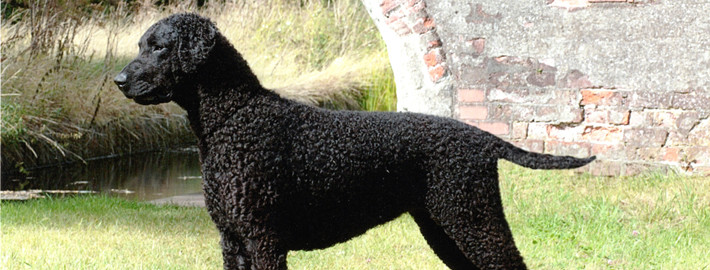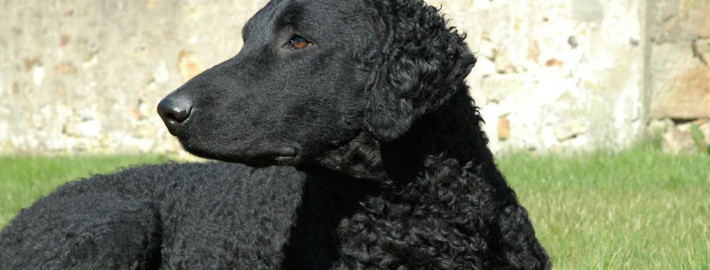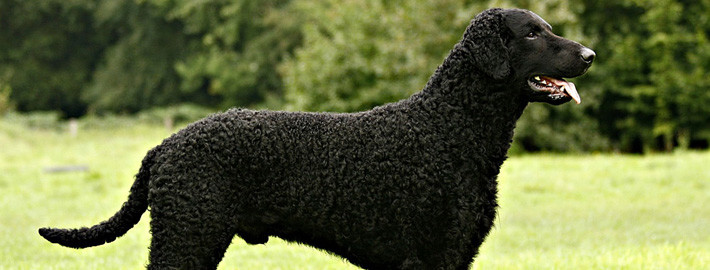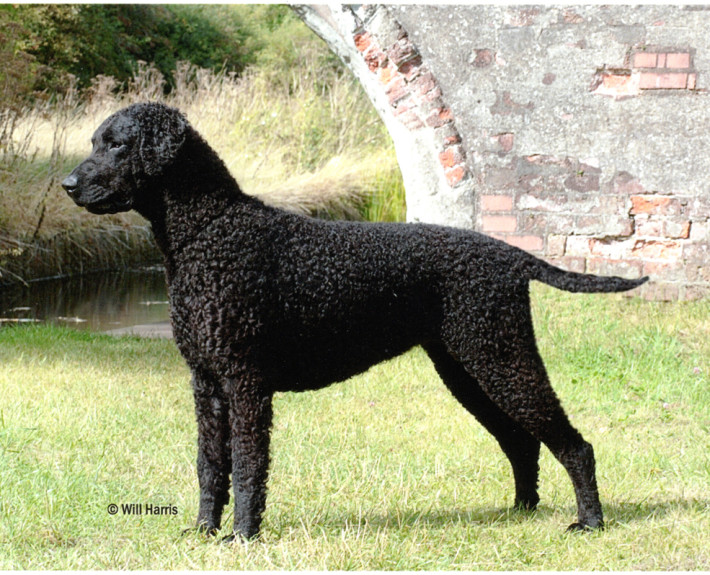What makes the Curly Coated Retriever Unique?
With the ability to retrieve game equally well in both the water and on land, Curly Coated Retrievers make a fine addition to active hunting families that live in temperate climates.
Breed Groups
Page Contents
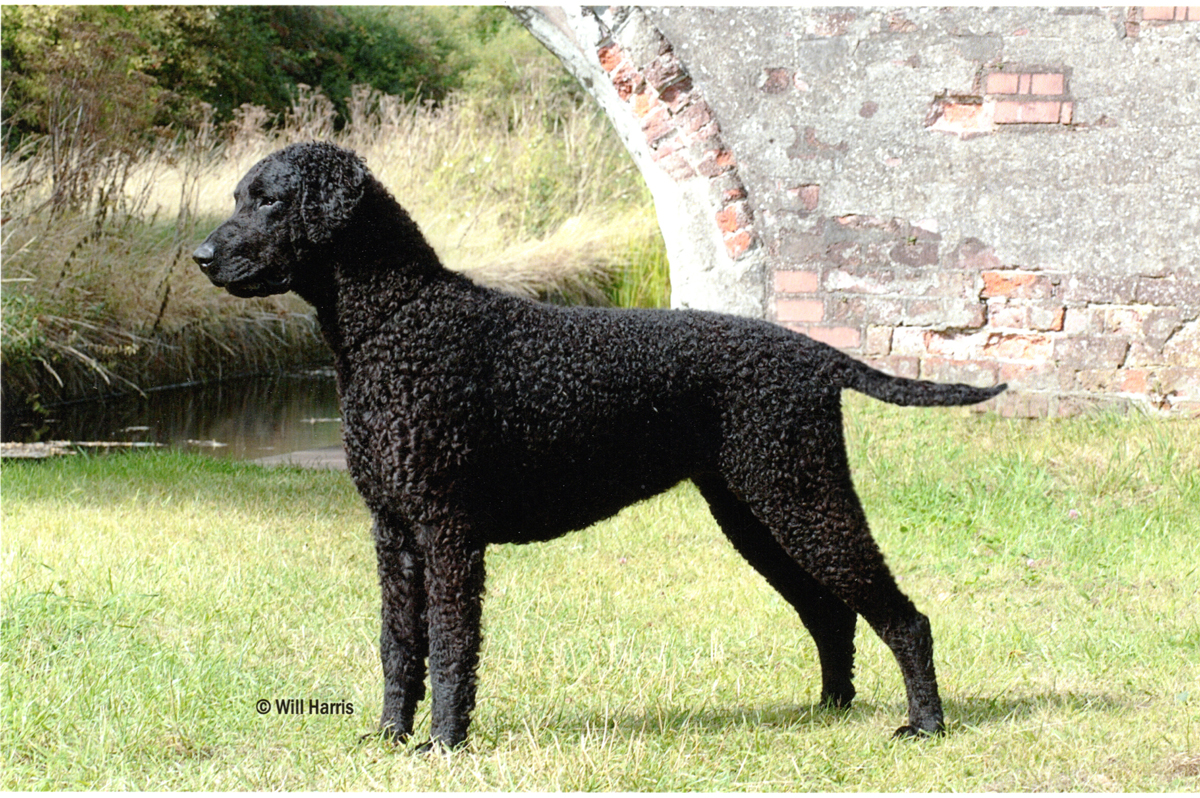
Is the Curly Coated Retriever Right For You?
These dogs are easygoing and eager to please, but they are not suitable for all families. Curly Coated Retrievers are very active dogs that go nonstop from sunrise to sunset. They also retain their puppy-like personalities for about three years. Furthermore, members of this breed need human contact in order to happy. Curly Coated Retrievers should be allowed to sleep indoors with members of their human families, but they will nonetheless enjoy spending time outdoors in a safely fenced yard during the day. Owners should further be aware that these dogs are not recommended for apartment life due to their high exercise needs.
In 5 Words
- Alert
- Docile
- Friendly
- Responsive
- Courgeuos
Characteristics
Learn About the Curly Coated Retriever
Description
General Description
Curly Coated Retrievers are robust, medium sized dogs with proportionate bodies and athletic appearances. They also possess lengthy heads, tapered muzzles, arched necks, deep chests, and level backs. Members of this breed should have a scissors bite. Small, pendant ears are another breed feature. Curly Coated Retrievers have sizable noses and almond-shaped eyes. Black dogs will have a nose of the same hue and eyes that range in color from brown to black. Meanwhile, members of this breed that have liver colored coats will have brown noses and eyes that range in color from amber to brown. Sturdy, straight legs can also be found on these retrievers. Members of this breed additionally possess a tapered tail that does not curve over their backs. Even in places where the practice is not illegal, their tails are left undocked.
Size
On average, female dogs stand between 23 and 25 inches (58.5 and 63.5 centimeters) in height, while males can be anywhere from 25 to 27 inches (63.5 to 68.5 centimeters) tall. Curly Coated Retrievers of both genders tend to weigh about 55 to 75 pounds (25 to 33.5 kilograms).
Coat
Members of this breed possess a coarse coat with tight spiral curls that are densely packed together. This feature helps protect the dogs from the rough vegetation that they may encounter over the course of their duties. Their waterproof fur is also resistant to inclement weather. Curly Coated Retrievers are typically black or reddish brown in color, with the latter hue being more commonly referred to as “liver”.
Short History of the Curly-Coated Retriever
Although Curly Coated Retrievers have somewhat obscure origins, these dogs first appeared in England during the late 1700s. They are one of the oldest retriever types in existence today. The breed is thought to initially be a cross between the St. John’s Newfoundland, the Retrieving Setter, and the English Water Spaniel. During the latter portion of the 1800s, Poodles were also introduced into this breed’s bloodline.
By the 1850s, Curly Coated Retrievers were quite popular in their homeland and they were shown in some of the nation’s first dog shows. Before the turn of the century, members of this breed made their way over to New Zealand and Australia where they were used to hunt game birds. An English breed club was eventually started in 1896. Curly Coated Retrievers came to the United States in the early 1900s and the first members of the breed were registered with the American Kennel Club (AKC) as early as 1924. However, these dogs did not become as prevalent in the United States as they have been in New Zealand and Australia.
Temperament
On the whole, Curly Coated Retrievers are polite, well-mannered individuals. Members of this breed will be great playmates for children. While these dogs tend to exhibit good hunting skills, they also know how to behave themselves indoors. These dogs typically get along well with other pets, but owners should note that members of this breed may be standoffish around unfamiliar people. Early socialization is a good way to prevent Curly Coated Retrievers from becoming overly timid or shy. However, members of this breed often make excellent watchdogs.
These dogs are easygoing and eager to please, but they are not suitable for all families. Curly Coated Retrievers are very active dogs that go nonstop from sunrise to sunset. They also retain their puppy-like personalities for about three years. Furthermore, members of this breed need human contact in order to happy. Curly Coated Retrievers should be allowed to sleep indoors with members of their human families, but they will nonetheless enjoy spending time outdoors in a safely fenced yard during the day. Owners should further be aware that these dogs are not recommended for apartment life due to their high exercise needs.
Caring for Your Curly Coated Retriever
General Health
Although members of this breed are typically healthy and have an average lifespan of about 10 years, known ailments that can arise from time to time include corneal dystrophy, progressive retinal atrophy, skin problems, cancers, cataracts, arthritis, epilepsy, and bloat. Various forms of dysplasia are not uncommon in members of this breed and hip dysplasia in particular is a major health concern. Outward and inward folding eyelids as well as ingrown eyelashes have been known to occur occasionally as well. It is recommended that owners have their pet’s hips tested regularly in order to identify any underlying conditions before they become problematic.
Care
Daily
Curly Coated Retrievers need vigorous daily exercise. These incredibly active dogs will do just fine with a briskly paced walk around their neighborhoods but they may also enjoy going swimming or playing lively games of fetch. Members of this breed that are allowed to become bored or that are not given long enough workouts have been known to resort to destructive behaviors.
Weekly
It is a good idea to regularly brush a dog’s teeth in order to prevent both foul breath and tartar buildup.
Monthly
All pets require flea, heartworm, and tick prevention medications to keep them healthy. These products are usually administered on a monthly basis.
Grooming & Bathing
Except for when the dogs are shedding, members of this breed should not be brushed because doing so will cause their coats to become unruly. Curly Coated Retrievers that are suffering from frizzy coats will need to have their fur dampened to return it to its former state. Untidy hairs should be trimmed with scissors and toenails should likewise be kept cut short. Members of this breed will need to be bathed only when they get dirty.
Exercise & Training
Curly Coated Retrievers are reasonably intelligent and easily trained. Although they don’t learn as fast as some other breeds do, they respond well to commands. These dogs are best suited for experienced owners that know how to handle their occasional bouts of stubborn behavior. Owners should also note that varied and interesting lessons are an important factor in training this breed. After all, Curly Coated Retrievers quickly succumb to boredom and will ignore lessons that have become repetitive.

